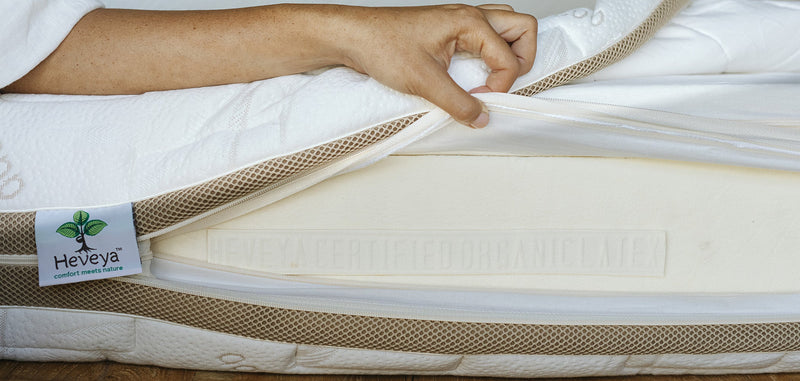Allergy sufferers know that congestion, runny nose and itchy watery eyes make for a very difficult night's sleep. But fewer sufferers are aware that their mattress can have a big effect on their allergies. A mattress which is allergen-resistant can offer welcome relief from unpleasant allergies.
What are the causes of allergies in bed?
Allergies can be triggered by a variety of things. The most common causes of allergies in bed are dust mites, mould spores, and pet dander.

Dust mites
Dust mites are tiny creatures which feed on flakes of human skin. They are therefore commonly found anywhere that people live. Because we tend to shed flakes of skin as we sleep, dust mites are especially prevalent in bedding. Dust mites prefer relatively high humidity levels, which is why they can often be found in bedding.
Dust mites are unappealing but do not actually bite or spread disease. However, they are harmful to people who are allergic to them. A dust mite allergy occurs when a person reacts to proteins from the body and fecal material of the dust mites. The symptoms of dust mite allergy may vary from one person to another, but generally include a runny nose and sneezing. In more severe situations, this may be present in the form of asthma.
A latex mattress is the best type of mattress for those with dust mite allergies. This is because latex is made from the sap of the rubber tree, which is naturally dust mite resistant. In contrast, an innerspring mattress with its many layers of padding and construction is a breeding ground for dust mites.
Mould spores
Mould spores are a major but often overlooked cause of allergies. Do you have allergy symptoms year-round which worsen during damp weather? If so, it is possible that you may be allergic to mould spores. Mould is a fungus, and even if you do not see spots of mould, they can be present inside and outside the home. In particular, warm and humid environments cause mould to thrive.
A mould allergy happens when someone reacts to the chemical compounds released by these spores. The most common symptoms of mould allergy involve upper respiratory problems, coughing and sinus drainage. Anything you can do to discourage growth of mould will decrease mould allergies. Keeping the home as cool and dry as possible will help.
Selecting a mattress which is mould resistant is one of the best things you can do if you are an allergy sufferer. A latex mattress is the best possible choice you can make in this regard, because latex is naturally mould resistant. Its composition, from the sap of the rubber tree, is just not a conducive environment for mould to grow. In contrast, many other types of foam and mattresses with a lot of cloth-like material are a good breeding ground for mould spores.
Pet dander
Pet dander - flakes of dead skin from your cat or dog - can cause allergy symptoms in sufferers. Runny nose, itchy eyes, coughing and sneezing are typical symptoms of pet dander allergies.
Pet dander can get everywhere in the home, even places where the pet has not ventured. For example, even a house guest who arrives without their pet may have dander clinging to them or their luggage. This dander unintentionally spreads around in your home.
In this situation the best thing to do is to avoid contact with pets as much as possible. For those who have allergies while sleeping, it is critical to disallow pets on the bed or into the bedroom at all.
How can I make my bedroom safe from allergens?
The good news is that there is a lot you can do to give yourself relief from troublesome allergies. Although you can never get rid of every allergen particle, you can work to decrease them to a manageable level where your symptoms become less severe or frequent. When you follow these tips, bedtime need not cause you misery with extra coughing and sneezing.

Update your old mattress with a new latex mattress
The best type of mattress for allergy sufferers is a latex mattress. It is naturally mould resistant and dust mite resistant. Virtually all other types of mattresses are a breeding ground for dust mites and mould, as well as being a collection point for pet dander. These particles are virtually impossible to get out of a mattress once they are there. For example, by sleeping on an old innerspring mattress, you are breathing in all these allergens whenever you sleep. With a new latex mattress, you can be rest assured that you'll be sleeping on a safe, hygienic environment and it will stay that way, due to its natural allergen-free properties.
Opt also for a mattress that comes with a removable and washable cover. Just like your bed sheets, the mattress cover can collect dust, mould and bacteria. Periodically washing it will help reduce the amount of allergens that stay on your bed. At Heveya®, all of our latex mattresses come with a removable-cleanable mattress cover. This way, you can take control of your mattress hygiene and relax knowing that you're sleeping in a hygienic and fresh environment
Avoid upholstery in your bedroom
Your new latex mattress will make a huge difference - but you will still need to keep other areas of your room safe from allergens. Upholstery of any kind, such as stuffed chairs and upholstered headboards, can attract allergens and are extremely difficult to clean. You simply cannot get the allergens out of upholstery. Instead, go with wood and glass furniture. A clean-cut modern look is about more than just aesthetics. It's about having surfaces which can easily be wiped down to remove every trace of allergens.
Vacuum regularly
Vacuuming at least twice a week is especially important in any carpeted areas, which can otherwise collect allergens. For allergy sufferers, not just any vacuum will help. You'll need one with a HEPA filter - otherwise the allergens will not be trapped by the vacuum and simply go back into circulation in the air again. Fortunately, most of the newer vacuums today come with HEPA filters. Being vigilant about vacuuming will help keep your bedroom allergen-free.
Do not also forget window treatments. Your curtains and blinds can collect a lot of dust, which attract dust mites and trigger allergies. You don't want that when you're trying to get a good night's sleep. So instead of dry-clean only curtains, opt for washable ones and wash them frequently. Make sure your blinds are easy to clean, and keep a regular cleaning regimen for these.
You do not need to put up with more restless nights with watery eyes, runny nose, coughing and sneezing. There is so much you can do to make your bedroom safe for you from allergies.
If you are an allergy sufferer, the best mattress for you is a latex mattress because it is naturally allergen-free. Not only will a latex mattress decrease your allergy symptoms at night, but its sheer luxury and restfulness will help your whole body feel better.









